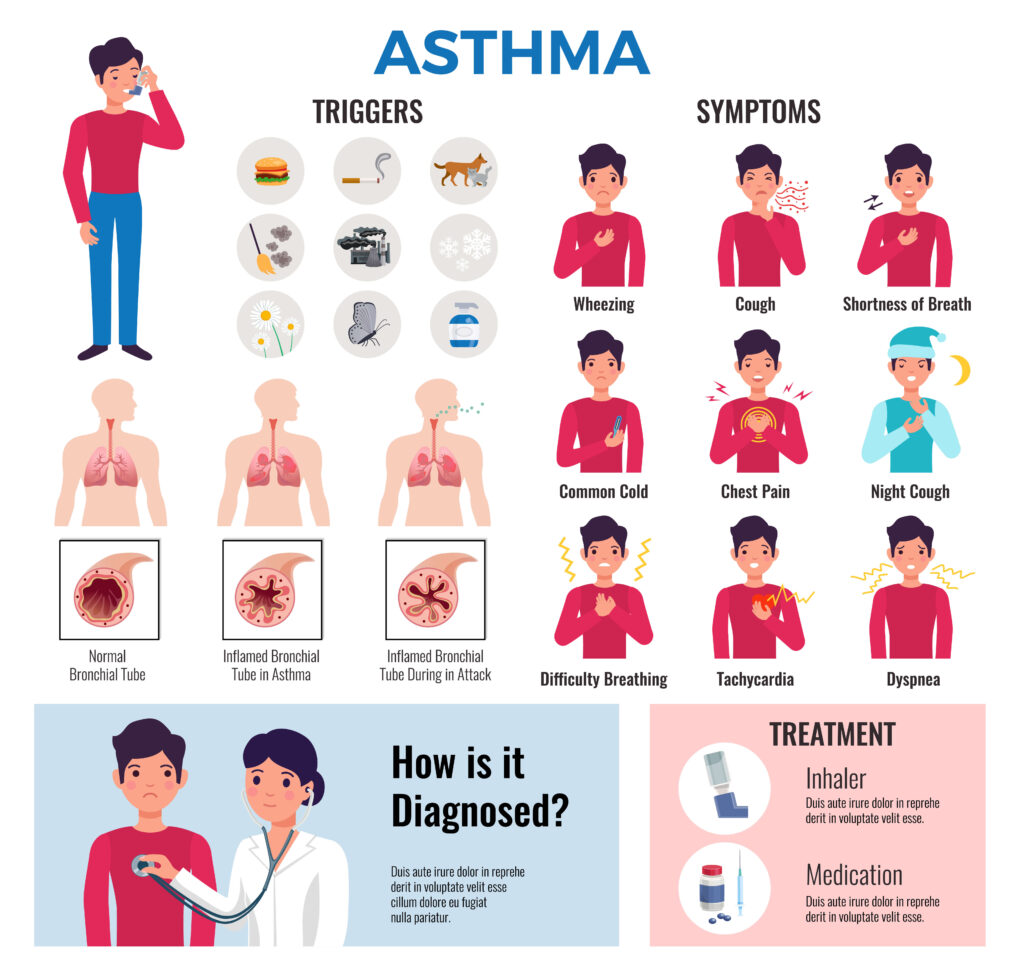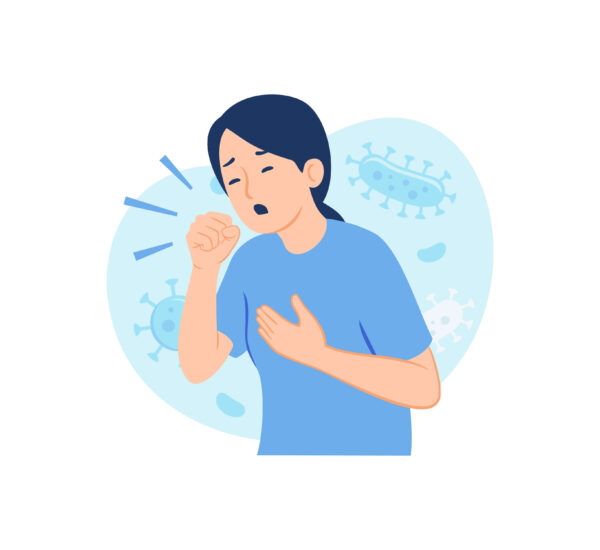Are you or a loved one newly diagnosed with asthma? Don’t worry, you’re not alone. Asthma is a common chronic respiratory condition that affects people of all ages. In this comprehensive guide, we will break down the basics of asthma, including its definition, common symptoms, causes and risk factors, different types, diagnosing methods, and treatment options. By the end of this article, you will have a better understanding of asthma and how to manage it effectively.
What is Asthma?
Asthma is a chronic lung disease characterized by inflammation and narrowing of the airways. This inflammation and narrowing make it difficult for air to flow in and out of the lungs, leading to symptoms such as wheezing, coughing, chest tightness, and shortness of breath. Asthma episodes, also known as asthma attacks, can range from mild to severe and can be triggered by various factors.
Asthma is a condition that affects millions of people worldwide. It is estimated that over 300 million people suffer from asthma, with the numbers increasing every year. This chronic disease can have a significant impact on a person’s quality of life, as it can limit their ability to engage in physical activities and even perform simple tasks.
Definition and Overview
According to the National Heart, Lung, and Blood Institute (NHLBI), asthma is a chronic inflammatory disorder of the airways that causes recurrent episodes of wheezing, breathlessness, chest tightness, and coughing. These episodes occur when the airways become inflamed and narrowed due to various stimuli.
The inflammation in the airways is a result of the immune system overreacting to certain triggers, such as allergens, pollutants, respiratory infections, and even exercise. This oversensitivity causes the bronchial tubes to produce mucus, leading to a characteristic wheeze. When exposed to these triggers, the airways become hypersensitive, leading to the characteristic symptoms of asthma.
Asthma affects approximately 25 million people in the United States alone, with both children and adults being susceptible to this condition. While asthma cannot be cured, it can be effectively managed with the appropriate treatment and lifestyle adjustments.
Managing asthma involves a combination of medication, avoiding triggers, and adopting a healthy lifestyle. Inhalers, which deliver medication directly to the airways, are commonly used to relieve symptoms and prevent asthma attacks. In addition to medication, individuals with asthma are often advised to identify and avoid triggers that can worsen their symptoms, such as pollen, dust mites, pet dander, and smoke.
Common Symptoms of Asthma
The symptoms of asthma can vary from person to person and may range from mild to severe. Some common symptoms of asthma include:
- Chronic cough, particularly at night or early morning
- Wheezing, a whistling sound when breathing
- Shortness of breath or difficulty breathing
- Chest tightness or pain
- Feeling tired or weak during physical activities
If you experience any of these symptoms, it is essential to consult a healthcare professional, as they can help determine if asthma is the cause and develop an appropriate treatment plan.
It is important to note that asthma symptoms can vary in severity and frequency. Some individuals may experience symptoms only during specific seasons or when exposed to certain triggers, while others may have persistent symptoms throughout the year. Understanding and managing these symptoms is crucial in maintaining a good quality of life for individuals with asthma.

Causes and Risk Factors for Asthma
Asthma is a complex condition with both genetic and environmental factors contributing to its development. Understanding the causes and risk factors can help individuals and healthcare providers better manage and prevent asthma symptoms.
Genetic Factors
Research has shown that asthma often runs in families, suggesting a genetic component. If one or both of your parents have asthma, you may be more likely to develop the condition. However, it is important to note that genetics alone cannot predict asthma development, and other factors also play a significant role.
Genetic studies have identified certain genes that are associated with an increased risk of developing asthma. These genes are involved in the regulation of the immune system and the response to inflammation. However, having these genes does not guarantee that an individual will develop asthma, as other factors such as environmental triggers and lifestyle choices also come into play.
Furthermore, researchers are still working to understand the complex interactions between genetic and environmental factors in asthma development. It is believed that genetic variations may make individuals more susceptible to certain environmental triggers, leading to the development of asthma symptoms.
Environmental Factors
Various environmental factors can trigger asthma symptoms or exacerbate existing symptoms. These triggers can include:
- Allergens, such as pollen, dust mites, pet dander, and mold
- Irritants, including tobacco smoke, air pollution, chemicals, and strong odors
- Respiratory infections, such as the common cold or flu
- Physical exertion or exercise
- Weather changes, especially cold air or extreme humidity
- Stress and strong emotions
Exposure to these triggers can cause inflammation and narrowing of the airways, leading to asthma symptoms such as wheezing, coughing, and shortness of breath.
Allergens, such as pollen and dust mites, are common triggers for asthma symptoms. These microscopic particles can be inhaled and cause an immune response in individuals who are sensitive to them. The immune system reacts by releasing chemicals that cause inflammation in the airways, making it difficult to breathe.
Irritants, such as tobacco smoke and air pollution, can also worsen asthma symptoms. These substances can irritate the airways and trigger an inflammatory response. Chemicals and strong odors can have a similar effect, causing airway inflammation and constriction.
Respiratory infections, such as the common cold or flu, can be particularly problematic for individuals with asthma. The infection can cause increased inflammation in the airways, making it harder to breathe. It is important for individuals with asthma to take preventative measures, such as practicing good hand hygiene and getting vaccinated, to reduce the risk of respiratory infections.
Physical exertion or exercise can also trigger asthma symptoms in some individuals. This is known as exercise-induced asthma. During physical activity, breathing becomes faster and deeper, which can lead to airway narrowing and symptoms such as wheezing and coughing. However, with proper management and medication, individuals with exercise-induced asthma can still participate in physical activities.
Weather changes, especially cold air or extreme humidity, can also trigger asthma symptoms. Cold air can cause the airways to constrict, making it harder to breathe. Similarly, high humidity can lead to the growth of mold and other allergens, which can trigger asthma symptoms in susceptible individuals.
Lastly, stress and strong emotions can also contribute to asthma symptoms. When individuals experience stress or intense emotions, their breathing patterns may change, leading to shallow or rapid breathing. This can trigger asthma symptoms or make existing symptoms worse. It is important for individuals with asthma to manage stress and practice relaxation techniques to help prevent symptom flare-ups.
Identifying and avoiding these triggers whenever possible can help reduce the frequency and severity of asthma symptoms. Working closely with healthcare providers and developing an individualized asthma management plan is crucial in effectively managing the condition and improving overall quality of life.
Different Types of Asthma
Asthma can be further categorized into different types based on its triggers and underlying mechanisms. Understanding the different types can help healthcare providers tailor treatment plans to suit individual needs.
Allergic Asthma
Allergic asthma, also known as extrinsic asthma, is the most common type of asthma. It is triggered by allergens such as pollen, dust mites, pet dander, and mold. People with allergic asthma often have other allergic conditions, such as hay fever or eczema. Allergic asthma symptoms typically occur after exposure to specific allergens.
Non-Allergic Asthma
Non-allergic asthma, also known as intrinsic asthma, is triggered by factors other than allergens. These triggers can include respiratory infections, exercise, cold air, air pollution, or irritants such as tobacco smoke or strong odors. Non-allergic asthma symptoms can occur at any time and may not be associated with specific allergens.
Occupational Asthma
Occupational asthma is a type of asthma that is triggered by exposure to substances in the workplace. These substances could be chemicals, dust, gases, or fumes. Individuals who work in industries such as manufacturing, agriculture, or healthcare may be at a higher risk of developing occupational asthma. Prompt identification and removal of these triggers from the workplace are critical to managing this type of asthma.
Diagnosing Asthma
Proper diagnosis is essential for effective asthma management. Healthcare providers use a combination of medical history, physical examination, and diagnostic tests to diagnose asthma accurately.
Medical History and Physical Exam
Your healthcare provider will start by asking about your medical history and symptoms. They will inquire about any family history of asthma or allergies, previous respiratory infections, exposure to potential triggers, and the frequency and severity of your symptoms. They will also perform a physical examination, focusing on your lungs and respiratory system.
Lung Function Tests
Lung function tests, also known as pulmonary function tests, are essential for diagnosing and monitoring asthma. These tests help measure the amount of air you can exhale forcefully and how fast you can do it. Spirometry is one of the most common lung function tests used to assess asthma. It involves breathing into a device called a spirometer, which measures your lung function.
Additional Tests
In some cases, additional tests may be necessary to gather more information about your asthma. These tests may include allergy testing to identify specific triggers, imaging tests such as chest X-rays or CT scans, or bronchial provocation tests to determine how your airways react to certain stimuli.
Treatment Options for Asthma
While there is no cure for asthma, various treatment options can help manage symptoms, reduce inflammation, and prevent asthma attacks. The goal of treatment is to allow individuals with asthma to live normal, active lives without experiencing significant limitations or complications.

Medications and Inhalers
Medications are a crucial part of asthma treatment. Depending on the severity and type of asthma, your healthcare provider may prescribe different medications. These can include:
- Inhaled corticosteroids to reduce airway inflammation
- Short-acting bronchodilators to provide quick relief during asthma attacks
- Long-acting bronchodilators to help control symptoms on a long-term basis
- Leukotriene modifiers to decrease airway inflammation and relax the muscles around the airways
- Immunomodulators, such as monoclonal antibodies, to target specific immune responses associated with asthma
Inhalers, such as metered dose inhalers (MDIs) or dry powder inhalers (DPIs), are the most common method of delivering these medications directly to the airways.
Lifestyle Changes
In addition to medications, certain lifestyle changes can help manage asthma effectively. These may include:
- Avoiding known triggers, such as allergens or irritants
- Using a peak flow meter to monitor lung function
- Creating an asthma action plan with your healthcare provider to guide your self-management
- Engaging in regular physical activity to strengthen the respiratory system
- Employing relaxation techniques and stress management to reduce the impact of stress on asthma symptoms
It is important to note that lifestyle changes should be personalized to individual needs and should be discussed with a healthcare professional.
Emergency Treatments
While treatment aims to prevent asthma attacks, emergencies can still occur. It is important to have an emergency action plan in place for severe asthma attacks. This may include the use of rescue medications, such as short-acting bronchodilators, and seeking immediate medical attention if symptoms worsen despite treatment.

Your Doctor
While self-care strategies and lifestyle modifications play a vital role, open communication with healthcare professionals remains the cornerstone of successful asthma management. Patients should actively engage in conversations with their doctors to establish personalized treatment plans, address concerns, and make informed decisions about their asthma care. Check out the doctors that are part of the Philippine Society of Allergy, Asthma and Immunology (PSAAI) as well as the best Allergist and Immunologist and Pulmonologists in the Philippines.
Regular check-ups and discussions about symptom changes, medication adjustments, and potential triggers enable doctors to tailor their recommendations to individual needs. By fostering this collaborative relationship, individuals can proactively manage their asthma, optimize their treatment strategies, and ultimately lead healthier, more active lives. Remember, your doctor is your ally in this journey towards better asthma control, providing the expertise and support you need to breathe easier.
In conclusion, asthma is a chronic respiratory condition characterized by inflammation and narrowing of the airways. It can be triggered by various factors, including genetic and environmental factors. Understanding the different types of asthma, along with proper diagnosis and treatment, is crucial in managing this condition effectively. With the right knowledge and support, individuals with asthma can lead normal, active lives and minimize the impact of symptoms on their daily activities.



